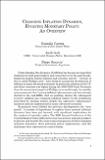Mostrar el registro sencillo del ítem
Changing inflation dynamics, evolving monetary policy: an overview
| dc.contributor.author | Castex, Gonzalo | |
| dc.contributor.author | Galí, Jordi | |
| dc.contributor.author | Saravia, Diego | |
| dc.date.accessioned | 2020-09-29T16:17:53Z | |
| dc.date.available | 2020-09-29T16:17:53Z | |
| dc.date.issued | 2020 | |
| dc.identifier.issn | 978-956-7421-67-1 | |
| dc.identifier.issn | 978-956-7421-68-8 (pdf) | |
| dc.identifier.uri | https://hdl.handle.net/20.500.12580/4878 | |
| dc.description | Understanding the dynamics of inflation has become an important challenge for both policymakers and researchers over the past decade. Empirical models linking inflation and economic activity—versions of the so-called Phillips curve—have failed to account for the behavior of inflation in many advanced economies. In particular, inflation in the U.S. and other countries was higher during the 2008-2009 Great Recession than the conventional empirical Phillips curve would imply. As noted by some economists, this “missing deflation” phenomenon may have already started in the mid-2000s. Just as puzzling, during the subsequent recovery, inflation has remained subdued relative to the predictions generated by existing models, despite the aggressive expansionary monetary policies implemented in many advanced economies. | es_ES |
| dc.description.abstract | Understanding the dynamics of inflation has become an important challenge for both policymakers and researchers over the past decade. Empirical models linking inflation and economic activity—versions of the so-called Phillips curve—have failed to account for the behavior of inflation in many advanced economies. In particular, inflation in the U.S. and other countries was higher during the 2008-2009 Great Recession than the conventional empirical Phillips curve would imply. As noted by some economists, this “missing deflation” phenomenon may have already started in the mid-2000s. Just as puzzling, during the subsequent recovery, inflation has remained subdued relative to the predictions generated by existing models, despite the aggressive expansionary monetary policies implemented in many advanced economies. | es_ES |
| dc.format | ||
| dc.format.extent | Sección o Parte de un Documento | |
| dc.format.medium | p. 01-05 | |
| dc.language.iso | en | es_ES |
| dc.publisher | Banco Central de Chile | es_ES |
| dc.relation.ispartof | Series on Central Banking Analysis and Economic Policies no. 27 | |
| dc.relation.ispartof | Serie Banca Central, análisis y políticas económicas, no. 27 | |
| dc.rights | Attribution-NonCommercial-NoDerivs 3.0 Chile | * |
| dc.rights.uri | http://creativecommons.org/licenses/by-nc-nd/3.0/cl/ | * |
| dc.subject | INFLACIÓN | es_ES |
| dc.subject | POLÍTICA MONETARIA | es_ES |
| dc.title | Changing inflation dynamics, evolving monetary policy: an overview | es_ES |
| dc.type.doc | Artículo |


